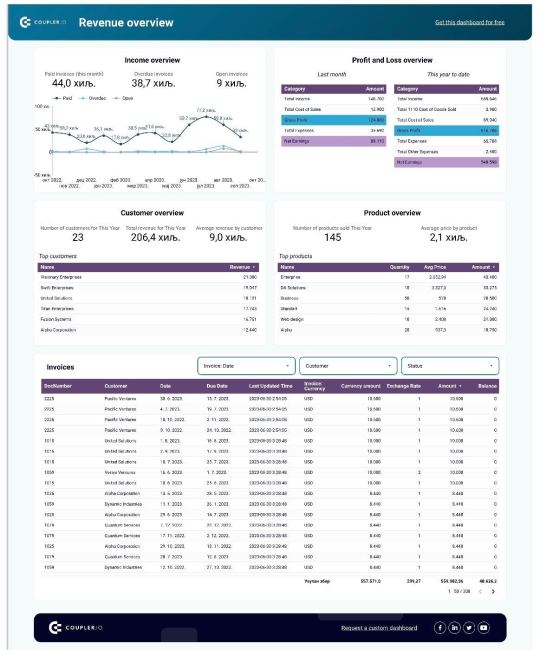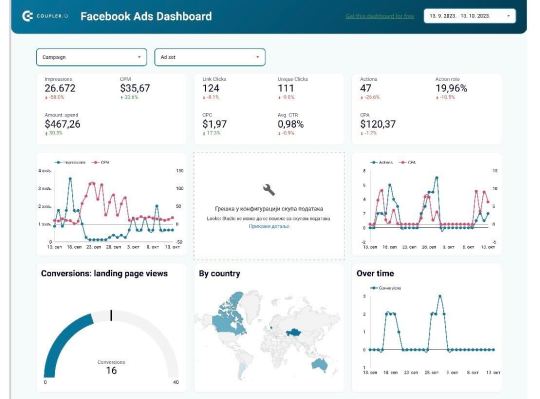#operational analytics
Explore tagged Tumblr posts
Text
Reasons To Prefer Operational Analytics Software For Enterprise Solutions
For every business, operational analytics takes a significant approach to establishing a new level of integration. As an owner or staff, you must use operational analytics software to use their data accordingly. It should be easy to secure the data and completely useful for gathering information on your operational purpose. The software will establish a clear-cut solution and operate the business successfully.
On the other hand, it will handle big data and analyze them completely with a business-focused approach. The customer experience is interesting and shifts towards the company's operational goals. The performance is always at a high level, and does the business within a short time.
Why Does An Enterprise Or Business Need Operational Analytics Software?
Enhance Performance And Margins
Most businesses today rely on the complete goal and reduce costs accordingly. It should be easy for business owners to take part in a streamlined process completely. It allows you to save money and be more efficient as well. Of course, it will increase the profits and help to improve the operations using the data. It will help gain profits and earn customer analytics depending on the requirements. The profits will be gained double, hence suitable for growing your business at a top level.
Better Decision Making
Making a proper decision is relevant to updating the organization with steady goals. Of course, it partakes the results and would prefer the best way to explore operational analytics. They take an important role and establish a new experience with proper decision business values. According to the requirements, they can handle everything based on operational analytics and are meant to explore new solutions.
Competitive Advantage And Handling Inefficiencies
Enterprise operational analytics seems the best thing and can explore many benefits. They can understand everything based on the efficient process. It gives you a better convenient solution and focuses on the analysis value. The customer data will be prompted with operational data and save money to reinvest in more profitable pursuits. The data will be evaluated based on the operational process and need to examine the results and time to connect well with the survey and make the process valuable.
Gain 100% Customer Satisfaction
Furthermore, enterprise operational analytics allows business owners to access counterintuitive and explores enhanced customer experience. The data can be accessed per the organization's goals and decrease customer needs. The operational analytics software gains more useful solutions and handles everything based on the factors to be considered. With operational analytics, it will gain root cause and be able to focus on performance issues and fix the right ways. Thus, customers must gain more insights about the business and handle everything based on customer satisfaction.
Streamlining Data
Security is the main thing we could see in the enterprise-level business. However, it should be valid and meant to get into the backup and recovery until the data is secured. Thus, it considers the vital role and manages it depending on the efficiency and handling spot system with problem-free solutions. You can easily gain customer insights, and employees will be satisfied working.
#enterprise operational analytics#operational analytics#operational analytics software#it operational analytics#advanced operational analytics
2 notes
·
View notes
Text
I feel extra bad repurposing my old laptop I technically replaced five years ago for GC data analysis because every time it needs to integrate a peak that’s not entirely perfectly even it has to work so hard it almost crashes the programs running, but instead of loudly complaining and running the fans like crazy like my current laptop it just quietly suffers through it until it gets the job done.
#stem student#chromatography#my laptop got to enjoy retirement for five years at least#now it’s back to statistics and trace analytics#screw my new computer not having the operating system for our old ass uni software
2 notes
·
View notes
Text
Augusta Ada King, Countess Lovelace (1815-52), a skilled mathematician, was the daughter of Lord Byron and a friend and colleague of Charles Babbage: 'the father of computers'. In 1843, she published a translation from Italian of a 'sketch' of Babbage's analytical engine with her own notes. It suggested the 'engine' could do more than calculation; she described an operations sequence, the first computer program.

"Normal Women: 900 Years of Making History" - Philippa Gregory
#book quotes#normal women#philippa gregory#nonfiction#augusta ada king#countess lovelace#ada lovelace#mathematician#lord byron#friends#colleagues#charles babbage#italian#translation#analytical engine#computer program#operations sequence#computing
4 notes
·
View notes
Link
3 notes
·
View notes
Text
Navigating Real-Time Operations: The Power of Operational Dashboards
Operational dashboards are dynamic visual interfaces that provide real-time insights into an organization's day-to-day activities and performance. These dashboards are particularly valuable for monitoring short-term operations at lower managerial levels, and they find application across various departments. They stand as the most prevalent tools in the realm of business intelligence.
Typically, operational dashboards are characterized by their comprehensive nature, offering junior managers detailed information necessary to respond to market dynamics promptly. They also serve to alert upper management about emerging trends or issues before they escalate. These dashboards primarily cater to the needs of managers and supervisors, enabling them to oversee ongoing activities and make rapid decisions based on the presented information. Operational dashboards often employ graphical representations like graphs, charts, and tables and can be customized to display information pertinent to the specific user.
Examples of data typically showcased on an operational dashboard include:
Sales figures
Production metrics
Inventory levels
Service levels
Employee performance metrics
Machine or equipment performance data
Customer service metrics
Website or social media analytics
It is crucial to emphasize that operational dashboards are distinct from other dashboard types, such as strategic and analytical dashboards. These different dashboards serve varied purposes and audiences and contain dissimilar datasets and metrics. Here are a couple of examples.
Below, you can see a Revenue overview dashboard for QuickBooks. It provides month-by-month overviews of invoices, products, customers, profit and loss. Such a dashboard can be used on a daily basis and help monitor and manage operating activities.
This data visualization is connected to a data automation solution, Coupler.io. It automatically transfers fresh data from QuickBooks to the dashboard, making it auto-updating. Such a live dashboard can be an important instrument for enabling informed decision-making.

This Revenue overview dashboard is available as a free template. Open it and check the Readme tab to see how to use it.
Here’s another example of an operational dashboard, the Facebook Ads dashboard. It allows ad managers to closely track their ad performance. This dashboard is also powered by Coupler.io, so it depicts ad data in near real-time. This allows marketers to quickly define what works and what doesn’t and make adjustments on the go.

Facebook Ads dashboard is available as a free template. You can grab it and quickly get a copy of this dashboard with your data. In conclusion, operational dashboards are indispensable tools for organizations seeking to thrive in a dynamic business landscape. These real-time visual displays offer invaluable insights into day-to-day operations, equipping managers and supervisors with the information to make swift, informed decisions. As the most widely used business intelligence instruments, operational dashboards empower businesses to adapt to market changes, identify emerging trends, and maintain a competitive edge. Their versatility and capacity to monitor a wide range of metrics make them an essential asset for managing the intricacies of modern operations.
#marketing dashboards#digital marketing#dashboards#data analytics#data visualization#operational dashboards
2 notes
·
View notes
Text
Remote Work Revolution: Job Vacancies in the Virtual Office
The way we work has undergone a seismic shift in recent years, and it's not just a passing trend. The Remote Work Revolution is here to stay, and it's transforming the job market as we know it. In this blog post, we'll explore the opportunities presented by this revolution and the myriad job vacancies that have emerged in the realm of the virtual office.

1. Remote Project Manager
Project management remains a vital function, even in a virtual office setting. Remote project managers oversee teams, set goals, and ensure that projects are completed efficiently and on time.
2. Virtual Administrative Assistant
Administrative assistants continue to play a crucial role in remote work. They manage calendars, coordinate meetings, and handle a wide range of administrative tasks that keep virtual offices running smoothly.
3. Digital Marketing Specialist
In a world where online presence is everything, digital marketing specialists are in high demand. They create and execute online marketing strategies, optimizing a company's visibility and reach in the digital landscape.
4. Software Developer
Remote software developers design, build, and maintain the software that powers the virtual office. They collaborate with global teams to develop applications, websites, and other digital solutions.
5. Customer Support Representative
The need for excellent customer support remains unchanged. Remote customer support representatives address customer inquiries and issues via email, chat, or phone, providing top-notch service from anywhere in the world.
6. Virtual Sales Representative
Sales teams have adapted to remote work, and virtual sales representatives connect with clients and prospects through virtual meetings and online communication channels.
7. Data Analyst
Data analysts gather and interpret data to provide insights that guide business decisions. Their work helps companies make data-driven choices, leading to improved efficiency and profitability.
8. Telemedicine Practitioner
The healthcare industry has embraced telemedicine, leading to job vacancies for remote doctors, nurses, therapists, and other healthcare professionals who provide medical consultations and care remotely.
9. Online Education Instructor
Online education has witnessed exponential growth, creating opportunities for online instructors who conduct virtual classes and offer remote support to students worldwide.
10. Content Creator
Content creators generate written, visual, or audio content for websites, blogs, social media, and other digital platforms. They play a critical role in engaging and informing virtual audiences.
11. Human Resources Manager
HR managers are responsible for recruiting, onboarding, and managing remote employees, ensuring a smooth and positive experience for all.
12. Cybersecurity Specialist
With the increased reliance on digital technologies, cybersecurity specialists are in high demand to protect company data and systems from cyber threats.
13. Virtual Event Planner
Virtual event planners design and coordinate virtual conferences, webinars, and other online gatherings, ensuring a seamless and engaging experience for attendees.
14. Remote Financial Analyst
Financial analysts analyze financial data to provide insights that drive business decisions, even from remote locations.
15. Online Psychologist or Counselor
Remote psychologists and counselors provide mental health support to clients through virtual sessions, expanding access to mental health services.
The Remote Work Revolution has unlocked a world of possibilities, allowing individuals to pursue meaningful careers while maintaining flexibility and work-life balance. The virtual office is no longer just a temporary solution; it's a fundamental shift in how we work, and it's opening up a wealth of job vacancies for those ready to embrace this new way of working. As remote work continues to evolve, these job vacancies will continue to adapt and expand, creating exciting opportunities for job seekers in the virtual office of the future.
#employee engagement#hr analytics and reporting#hrsoftware#hr operation#hr services#hr solutions#onboarding
2 notes
·
View notes
Link
Healthcare Analytics Software Development enables accurate and timely data analysis for better clinical decision-making, saving lives & costs.
According to a recent survey, the healthcare sector produces immense quantities of data via electronic medical records (EMR), electronic health records (EHR), and health information exchange (HIE). Nonetheless, the difficulty arises in competently examining and leveraging this data to enhance decision-making and proficiently manage it. Healthcare analytics software development services provide an answer to these predicaments.
Healthcare analytics can also be integrated with telemedicine app development and can help various features in this type of heathcare app development
#predictive analytics in healthcare#Healthcare Analytics Software#Healthcare Analytics Software Development#healthcare data analysis software#healthcare data analytics software#Healthcare Data Analytics#business intelligence software for healthcare#clinical analytics software#Clinical Decision Support Systems#data analytics software for healthcare#health analysis software#health catalyst data operating system#Health Information Exchange#healthcare bi software#Healthcare Business Intelligence#healthcare business intelligence tools#Healthcare Information Systems#healthcare predictive analytics software#hospital analytics software#Healthcare Quality Management#medical analytics software#medical data analysis software#Population Health Management#population health analytics software
2 notes
·
View notes
Text
youtube
#crypto market#fintech#finance#software#singapore#SynOption operates SYNCHRO#a Crypto Options Analytics and Trading Platform. Our dynamic OTC platform allows for trading of Crypto options in OTC and Exchange based fo#providing liquidity across exchanges#product suites#and alt-coins.#Key Features of Synchro - Crypto Options Analytics and Trading Platform#1. Multi Leg Strategies#2. Delta Cost Savings#3. Institutional Liquidity#4. RFQ Based Workflows#5. Multiple Clearing Venues#Youtube
2 notes
·
View notes
Text
Customer Service Relationship Management
Introduction to Customer Service Relationship Management
What is Customer Service Relationship Management (CSRM)?
Customer Service Relationship Management (CSRM) refers to the systematic approach of managing customer interactions and enhancing service delivery to build long-term, meaningful relationships. It focuses on addressing customer needs, resolving issues efficiently, and ensuring satisfaction through a blend of technology and human effort.
While traditional CRM systems emphasize sales and marketing, CSRM zeroes in on customer support and service processes to create a seamless experience.
Why is CSRM Important for Businesses?
Enhancing Customer Loyalty Effective CSRM fosters trust and loyalty by ensuring customers feel valued and heard. Loyal customers are more likely to advocate for the brand and provide repeat business.
Improving Operational Efficiency Centralized systems and streamlined workflows reduce redundancies, enabling quicker issue resolution and better service quality.
Gaining a Competitive Advantage In today’s customer-centric market, excellent service is a key differentiator. Businesses that prioritize CSRM stand out by delivering superior customer experiences.
Core Elements of Customer Service Relationship Management
Centralized Customer Data
Consolidating Information CSRM systems centralize customer data, making it easily accessible for service teams. This includes purchase history, preferences, and previous interactions.
Leveraging Data for Personalization Using this data, businesses can offer tailored solutions, making customers feel understood and valued.
Proactive Customer Support
Anticipating Customer Needs Proactive support involves identifying potential issues before they arise, like sending reminders about product updates or addressing frequently encountered problems.
Implementing Predictive Analytics Predictive analytics tools can analyze trends and customer behavior, helping teams forecast needs and provide preemptive solutions.
Integration with CRM Systems
Synchronizing Customer Interaction Data Integrating CSRM with existing CRM systems ensures a seamless flow of information across departments, improving customer interactions.
Cross-Functional Collaboration When sales, marketing, and support teams share insights, they can collaborate more effectively to meet customer needs holistically.
Benefits of Customer Service Relationship Management
Strengthened Customer Relationships Tailored interactions and a personalized approach foster trust and encourage long-term loyalty.
Enhanced Customer Satisfaction Quick and effective resolution of queries, along with self-service options, improves overall satisfaction.
Optimized Team Productivity By automating repetitive tasks and centralizing data, service teams can focus on complex issues, boosting efficiency.
Steps to Implement a CSRM Strategy
Assessing Customer Service Needs
Identifying Pain Points Conducting surveys and analyzing feedback helps identify recurring issues and areas for improvement.
Understanding Customer Preferences Determine the preferred channels and communication styles of your customers to tailor the strategy accordingly.
Selecting the Right Tools
Features to Look For Look for tools offering ticketing systems, analytics, AI capabilities, and omnichannel support.
Popular CSRM Platforms Platforms like Zendesk, Salesforce Service Cloud, and Freshdesk cater to businesses of various sizes and industries.
#What is Customer Service Relationship Management (CSRM)?#H3: Definition and Overview#H3: Difference Between CRM and CSRM#H2: Why is CSRM Important for Businesses?#H3: Enhancing Customer Loyalty#H3: Improving Operational Efficiency#H3: Gaining a Competitive Advantage#H1: Core Elements of Customer Service Relationship Management#H2: Centralized Customer Data#H3: Consolidating Information#H3: Leveraging Data for Personalization#H2: Proactive Customer Support#H3: Anticipating Customer Needs#H3: Implementing Predictive Analytics#H2: Integration with CRM Systems#H3: Synchronizing Customer Interaction Data#H3: Cross-Functional Collaboration#H1: Benefits of Customer Service Relationship Management#H2: Strengthened Customer Relationships#H3: Tailored Interactions#H3: Building Trust and Credibility#H2: Enhanced Customer Satisfaction#H3: Reduced Resolution Times#H3: Empowering Customers Through Self-Service#H2: Optimized Team Productivity#H3: Streamlined Workflow#H3: Better Resource Allocation#H1: Steps to Implement a CSRM Strategy#H2: Assessing Customer Service Needs#H3: Identifying Pain Points
0 notes
Text
Optimizing Performance: MSc in Data Analytics and Operations Management in London Situated in the Heart of London: Why Opt for Olympus International? The MSc in Data Analytics and... https://www.meoun.uk/optimizing-performance-msc-in-data-analytics-and-operations-management-in-london/?feed_id=88000&_unique_id=676eb92538e2a
#Stories#Analytics#Data#London#Management#MSc#MSc_Data_Analytics_and_Operations_Management_Course_in_London#Operations#Optimizing#Performance
0 notes
Text
Automatisasi Bisnis dengan Kekuatan AI
Automatisasi bisnis telah menjadi topik utama dalam dunia usaha modern. Dengan kemajuan teknologi kecerdasan buatan (AI), perusahaan kini memiliki peluang untuk mengoptimalkan proses mereka, meningkatkan efisiensi, dan mengurangi biaya operasional. AI tidak hanya menggantikan tugas-tugas manual yang berulang tetapi juga membawa kemampuan analisis data yang canggih, prediksi yang akurat, dan…
#AI automation#AI benefits#AI challenges#AI in banking#AI in business#AI in logistics#AI in retail#AI training#AI trends 2024#AI-powered tools#artificial intelligence#business automation#business innovation#cost reduction#customer experience#ethical AI#future of AI#operational efficiency#predictive analytics#scalable solutions#smart inventory management#supply chain management#workforce automation
0 notes
Text
Executive Management Programme in Supply Chain & Operations Analytics
As one of the leading educational institutions in India, IIT Delhi brings you an exceptional opportunity to master the art and science of supply chain & operations analytics. The Executive Management Programme in Supply Chain & Operations Analytics is meticulously designed to equip professionals with cutting-edge knowledge and practical skills essential for optimizing supply chain and operations processes. This comprehensive programme delves into advanced analytical techniques, strategic decision-making, and the latest technological advancements, ensuring participants are well-prepared to tackle complex challenges in the dynamic global market. Join us and embark on a transformative journey that will elevate your capabilities to new heights.
operations analytics certification
#iit delhi certificate courses#Executive Programme in Supply Chain Management#operations analytics certification
0 notes
Text
6 ways to improve front desk operations in a hotel

Implement a User-Friendly Property Management System (PMS)
Investing in a robust, user-friendly PMS can streamline many front desk functions, allowing for quicker guest check-ins and check-outs, and simplifying task management for staff. The right PMS can also automate functions like billing, housekeeping updates, and guest profile management, ensuring that information is centralized and accessible. With integrated technology, front desk staff can access real-time data and focus more on engaging with guests rather than juggling paperwork.
Example: Hotels can use cloud-based PMS solutions that integrate with mobile devices, enabling staff to manage bookings, room assignments, and other guest requests on-the-go. This type of flexibility can enhance the guest experience and make the front desk operation more agile.
Enhance Staff Training and Development
A knowledgeable and friendly front desk team is essential for smooth operations and creating positive guest experiences. Training programs should include customer service techniques, conflict resolution, cultural sensitivity, and technology skills to ensure that staff can handle a wide range of scenarios. By investing in ongoing training and development, hotels can empower front desk agents to respond confidently and professionally to any guest need.
Example: Implementing customer service role-playing sessions or workshops on handling difficult situations helps front desk staff feel more prepared and confident in high-pressure situations. This leads to quicker resolution of guest issues and enhances the overall service quality.
Leverage Mobile Check-In and Check-Out Options
Offering mobile check-in and check-out options can greatly improve convenience for guests, especially those who value minimal contact or are on tight schedules. With these digital options, guests can skip the line, access their room with digital keys, and receive important information directly on their mobile devices. This not only speeds up the process but also reduces wait times at the front desk, allowing staff to focus on more personalized interactions with guests.
Example: Hotels that allow guests to check in through an app or kiosk help reduce lobby congestion during peak hours, providing a smoother arrival experience. Mobile check-out also enables guests to settle their bills quickly and leave feedback immediately, fostering a positive and seamless end to their stay.
Create a Well-Organized and Efficient Workspace
Organization is key to smooth front desk operations. A clutter-free, well-designed workspace helps front desk staff access essential tools and information quickly, allowing them to serve guests efficiently. Organized storage, a clear filing system, and ergonomic workstation setups can reduce unnecessary steps and help staff focus on guest engagement rather than searching for items.
Example: Organizing desk drawers with labeled sections for different forms, supplies, and guest essentials can speed up routine tasks. Hotels could also use digital filing systems to eliminate paperwork, making it easier to retrieve guest data and reducing physical clutter.
Use Data Analytics for Forecasting and Staff Allocation
Data analytics can play a significant role in optimizing front desk operations. By analyzing guest flow patterns, seasonal demand, and peak hours, hotels can better predict staffing needs and ensure that they have adequate coverage. This approach prevents both overstaffing and understaffing, ensuring that guests receive timely service without additional operational costs.
Example: With data insights, front desk managers can allocate more staff during weekends, holidays, or major events when guest traffic is higher. During low-occupancy periods, they can redistribute front desk staff to other areas of the hotel, optimizing labor costs and efficiency.
Encourage Personalized Service and Attention to Detail
Personalized service can leave a lasting impression on guests and set a hotel apart from its competitors. Simple gestures, like addressing guests by name, remembering their preferences, or accommodating special requests, can enhance guest satisfaction. Front desk teams can leverage guest data from CRM systems to tailor their service approach, creating an experience that feels unique and memorable.
Example: If a guest is a returning visitor who previously requested extra pillows or specific room amenities, front desk staff can proactively arrange these before their arrival. Such attention to detail shows the guest that their preferences are valued and remembered.
Conclusion An efficient front desk operation is essential for a hotel’s success and guest satisfaction. By adopting advanced technology, continuously training staff, organizing the workspace, using data analytics for decision-making, and personalizing guest interactions, hotels can significantly enhance their front desk operations. These improvements lead to smoother guest experiences, higher retention rates, and a stronger brand reputation.
Additional Tips for Optimizing Front Desk Operations
Offer Multi-language Support: Having multilingual staff or digital translation tools can enhance communication with international guests.
Automate Routine Tasks: Automated notifications for housekeeping, maintenance, or guest requests can streamline coordination among departments.
Implement Guest Feedback Systems: Encourage guests to provide feedback during check-out, which can help the hotel address issues immediately and improve service.
#hotel front desk operations#property management system for hotels#user-friendly PMS software#streamline hotel check-ins#mobile check-in and check-out for hotels#efficient front desk management#guest experience improvement#cloud-based hotel PMS#staff training for hotels#hotel technology integration#data analytics for hotels#personalized guest service#hotel front desk workspace organization#automated hotel billing systems#hotel guest satisfaction strategies#hotels near me with digital check-in#advanced hotel PMS in Chennaia
0 notes
Text
are there any aus where anya quits nursing and decides to persue becoming a therapist instead bc i wanna see that
#tablet.talks#i mean she’s obsessed with awful real/ity sho/ws i think she really likes understanding how people operate#the way she interacts with others is so kind yet analytical?
1 note
·
View note
Text
What are the next steps after obtaining an insurance broker license, and how can you generate potential leads using Mzapp CRM software?
Congratulations on securing your insurance broker license! The journey doesn’t end here; it’s just the beginning of building a successful insurance brokerage. Here’s how you can proceed and leverage Mzapp CRM software to find potential leads:
Steps After Getting Your Insurance Broker License
Understand Your Market: Research your target audience (individuals, businesses, or specific sectors).
Develop a Business Plan: Set goals for client acquisition, revenue, and operational processes.
Build a Network: Partner with insurance providers and attend industry events to establish your presence.
Create an Online Presence: Build a professional website and maintain active profiles on social platforms.
Offer Value-Added Services: Educate customers on policies, claims management, and risk assessments.
Using Mzapp CRM Software to Generate Leads
Lead Capture: Utilize Mzapp’s integrated forms and web tracking tools to capture inquiries from your website or social media.
Automated Follow-Ups: Set up personalized email and SMS follow-ups to nurture leads effectively.
Lead Scoring: Prioritize leads based on their interaction history, ensuring you focus on high-potential prospects.
Data-Driven Campaigns: Use analytics to identify what works and launch targeted campaigns.
Seamless Policy Management: Impress leads by showcasing how smoothly you manage policies and claims through Mzapp.
Why Choose Mzapp CRM?
Mzapp CRM simplifies lead management, streamlines operations, and provides insights into customer behavior, making it easier to convert prospects into loyal clients.
Learn more about how Mzapp can transform your insurance business here.
#Question:#What are the next steps after obtaining an insurance broker license#and how can you generate potential leads using Mzapp CRM software?#Answer:#Congratulations on securing your insurance broker license! The journey doesn’t end here; it’s just the beginning of building a successful i#Steps After Getting Your Insurance Broker License#Understand Your Market: Research your target audience (individuals#businesses#or specific sectors).#Develop a Business Plan: Set goals for client acquisition#revenue#and operational processes.#Build a Network: Partner with insurance providers and attend industry events to establish your presence.#Create an Online Presence: Build a professional website and maintain active profiles on social platforms.#Offer Value-Added Services: Educate customers on policies#claims management#and risk assessments.#Using Mzapp CRM Software to Generate Leads#Lead Capture: Utilize Mzapp’s integrated forms and web tracking tools to capture inquiries from your website or social media.#Automated Follow-Ups: Set up personalized email and SMS follow-ups to nurture leads effectively.#Lead Scoring: Prioritize leads based on their interaction history#ensuring you focus on high-potential prospects.#Data-Driven Campaigns: Use analytics to identify what works and launch targeted campaigns.#Seamless Policy Management: Impress leads by showcasing how smoothly you manage policies and claims through Mzapp.#Why Choose Mzapp CRM?#Mzapp CRM simplifies lead management#streamlines operations#and provides insights into customer behavior#making it easier to convert prospects into loyal clients.#Learn more about how Mzapp can transform your insurance business here.
0 notes
Text
Real-time tracking systems are redefining logistics and warehouse operations by providing better control and transparency over the movement of goods. These technologies streamline processes, improve accuracy, and boost efficiency, making warehouse management more effective and reliable.
0 notes